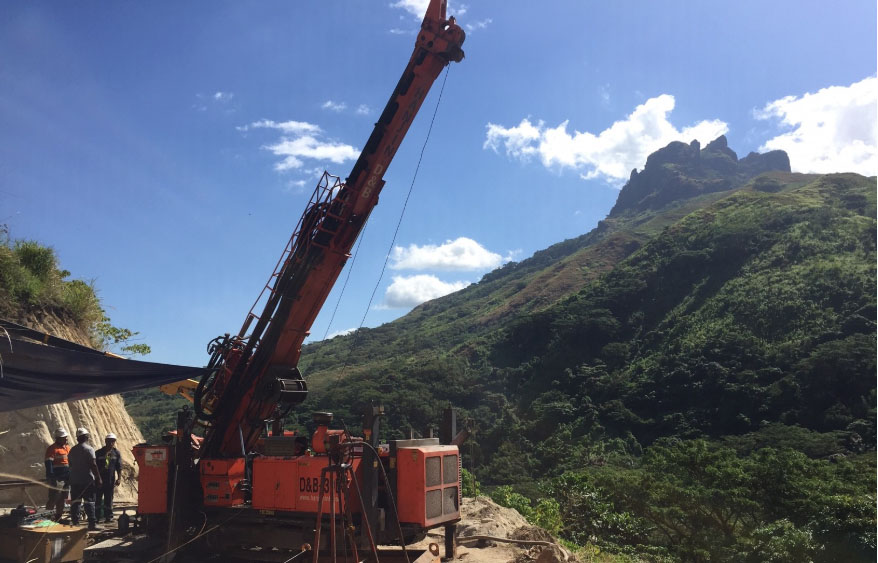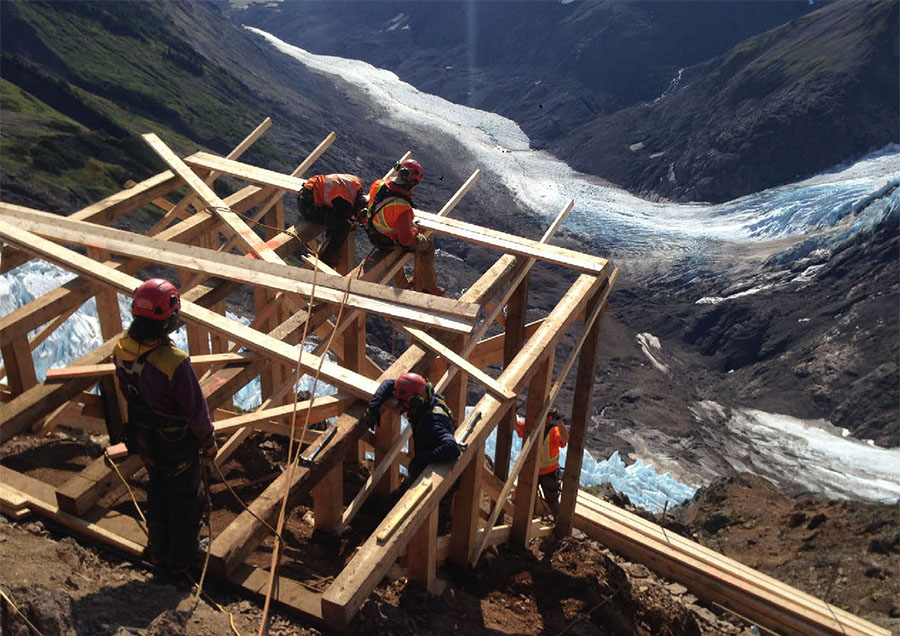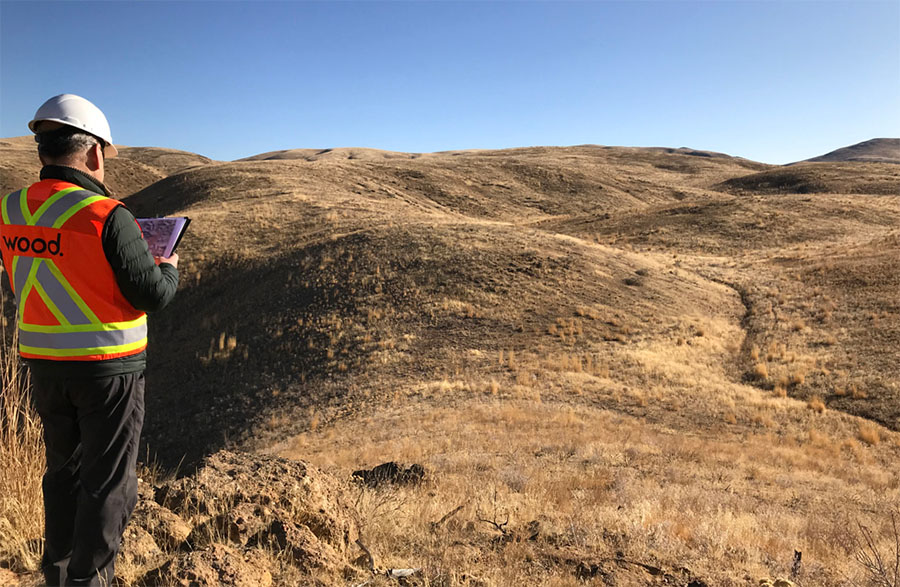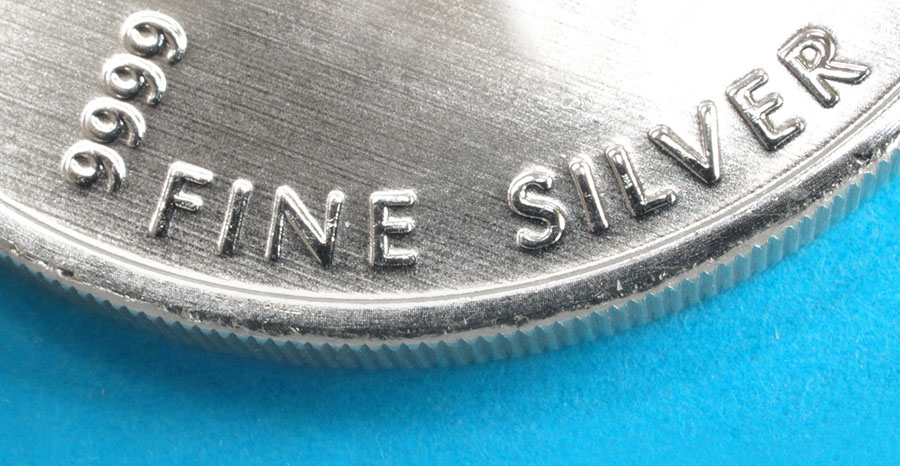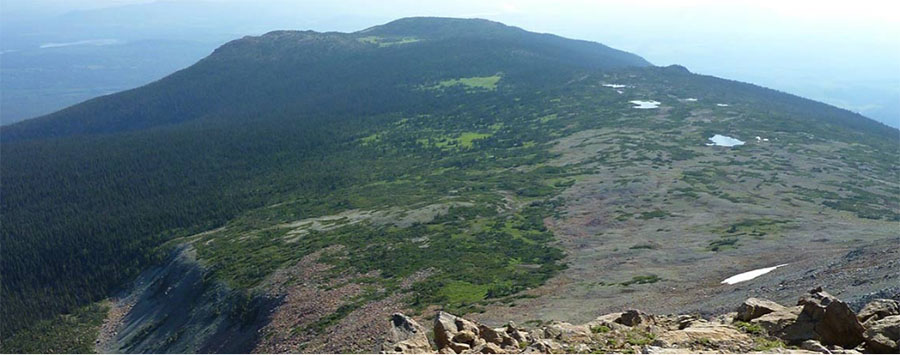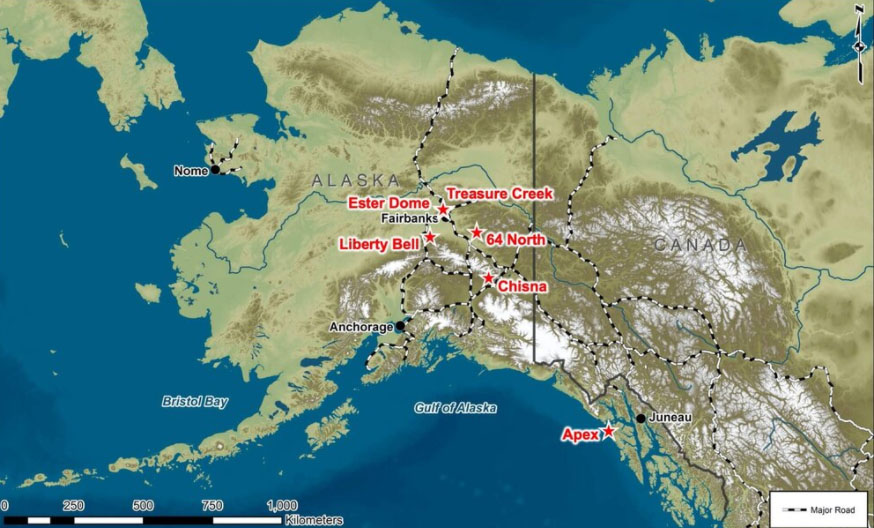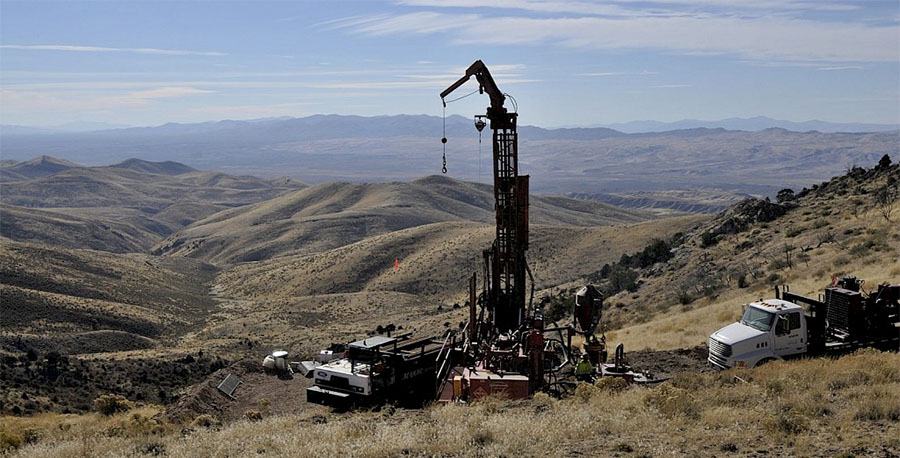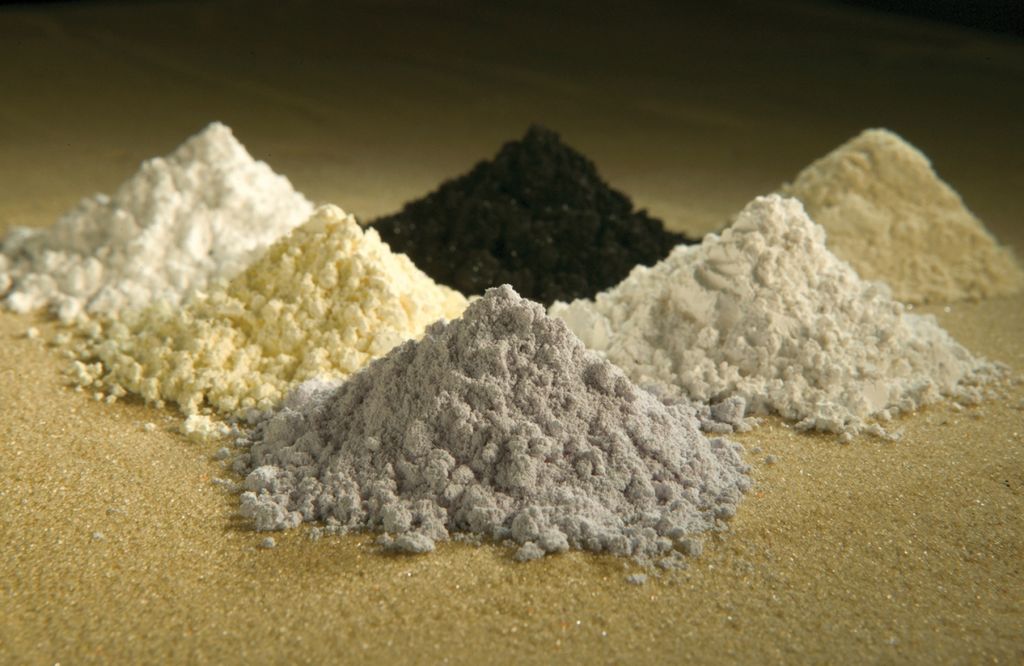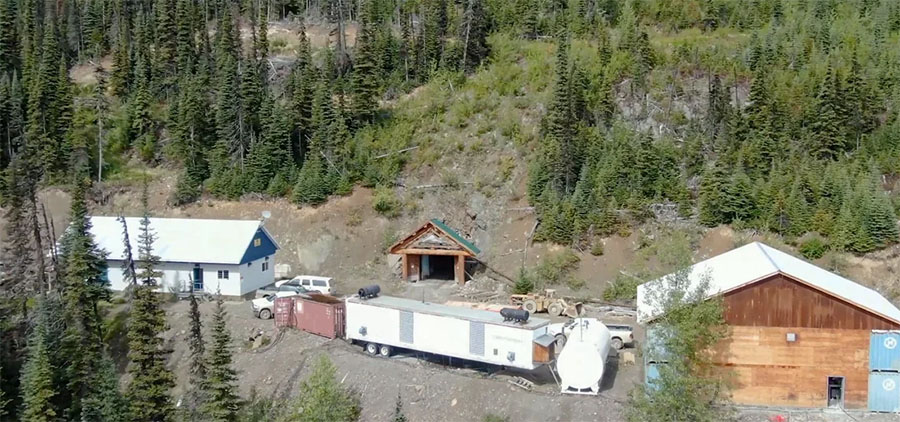TICKERS: AVL; AVARF, CMMC; CPPMF, FNV
John Kaiser: PDAC-Too Much of a Good Thing?
Interview
Source: Interviewed by Sally Lowder, The Gold Report (3/15/10)
 Thousands flock to PDAC about this time every year to pan for nuggets for their organizations or for themselves. In this exclusive Gold Report interview, Kaiser Bottom-Fish Report editor John Kaiser suggests that the bigger the event gets, the more patience and effort it seems to take, but those who are persistent and willing to dig can still cart away useful information and insights.
Thousands flock to PDAC about this time every year to pan for nuggets for their organizations or for themselves. In this exclusive Gold Report interview, Kaiser Bottom-Fish Report editor John Kaiser suggests that the bigger the event gets, the more patience and effort it seems to take, but those who are persistent and willing to dig can still cart away useful information and insights.
The Gold Report: You're a long-time participant in the annual PDAC convention. Everybody who wasn't able to be there wants to know about any compelling stories or particularly interesting tidbits that you learned this year, when the event brought people into Toronto from more than 100 countries around the world.
John Kaiser: In the past few of the 20 years I've been going to this conference—and this year is no exception—it has become increasing difficult to pick up any prominent buzz, be it about a sector being red hot or be it about a major new discovery.
TGR: Why do you suppose that's happening?
JK: The reason is simple; this conference has become so big, so global. What in 1994 would have been the big Voisey's Bay's buzz that everybody was talking about or Bre-X in the following year, even if something like this did come along now, the collective size of 400 companies exhibiting would dwarf it. There are several hundred trade show exhibitors; numerous talks covering everything from country-focused issues to deposit models to new discoveries and so on. It's very difficult for any single thing to stick out.
Even worse, because it is now so large and dispersed, you do not have that intensity of networking of the past, the random networking where you would bump into people you hadn't seen for a long time and hear about this or that. By the end of the conference you had all these bits and pieces gelling in your head and you could say, "Oh, yeah, this was what was interesting." No, now it's the more you know in advance what you're looking for; you make the sessions; you track down those companies, and you have the face-to-face you planned with these. So, the old aspect of serendipity of bumping into stuff and stuff floating to the surface just does not happen in this environment.
TGR: Did you have any specific goals for your newsletter or your personal business that you were able to accomplish at the conference?
JK: I always take in the commodity talks on Sunday. This year I found that very helpful, and one theme that did emerge is the growing role of hard assets as a target for managed money. Martin Murenbeeld (Commodities and Market Outlook, Gold/Silver; DundeeWealth Economics) emphasized that $40 trillion of about $117 trillion worth of financial assets in the world is so-called managed money. In other words, fund managers are running it. Of this $40 trillion, about $200 billion is in what you would call hard assets such as gold, silver, copper, ETFs, futures; these sorts of instruments linked to raw materials. Martin suggests that the trend is going from this relatively small sum to nearly $1.3 trillion; in other words, 3% of the managed money going into this category. Should this happen, there's nowhere near enough gold at the current prices.
In another talk on copper, a similar theme was raised. When you look at a 50-year chart, copper has historically followed this pattern when inventories in the warehouses build up—which is usually during a business cycle downturn such as we've just been in—the price of the commodity collapses along with it until all the inventories have been drawn down. And then they spike upwards.
After the spike downwards in 2008, copper prices are back almost where they were before the collapse. Warehouse levels—while not as bad as they were at the end of the '90s when inventories were very high and copper was at 60 cents—are about halfway there. Yet we have the higher inventories and higher prices tracking each other. The analysts are attributing this to the movement of investor capital into these hard assets that Martin was talking about, and they say that the inventories aren't just stuff parked in the warehouse because there's nobody to buy it. Instead, it's already allocated to investors speculating on higher prices down the road or even treating it as a hedge against a debasement of the currencies and so on.
TGR: So we're seeing that kind of growth not just in the precious metals space, but also in base metals. Did anybody address the idea of that kind of big money investment or fund investment in other metals besides even just base metals and gold?
JK: Yes, for example, nickel is really not supposed to be back at $9 because the old pig-iron nickel, which helped bring nickel back down from the $22 levels, was working at $11 and $12. Now they're able to make it work at $7 and $8, so there's plenty of nickel supply coming into the system. Still, nickel has managed to climb back to $9, while inventories are very, very healthy.
TGR: So it's affecting copper, nickel and gold.
JK: We are seeing it in all the categories. Even zinc, which is in surplus this year and is supposed to say in surplus next year, but then is expected to go into deficit. At that point, suddenly demand is greater than the supply. It is a $1 or higher and has bounced back significantly from the low reached during the 2008 meltdown.
TGR: Did you observe a lot of activity at the conference that you hadn't seen before, with fund managers sniffing around for compelling plays to work in what you're basically describing as a groundswell of money being diverted into these hard assets?
JK: I polled exhibitors as to what kind of traffic they were getting, and yes, they are receiving a lot of inquiries. They're coming from a range of sources, from the traditional European and North American institutional fund managers to a lot of overseas Asian-style managers. Of course, there's also interest from the end-user crowd.
A big theme has been China's movement to convert some of its foreign reserves into hard assets in terms of ownership of physical deposits. That's why we have seen buyouts and significant investments or large equity stakes in a number of important projects stranded during the 2008 meltdown. That was the nature of feedback I got from exhibitors.
TGR: Do you then anticipate more of the global relationships blossoming and developing as we saw last year with a major Asian investor—actually Japanese rather than Chinese—coming in as a strategic partner with a North American company?
JK: You're referring to the deal between Copper Mountain Mining Corp. (TSX:CUM) and Mitsubishi Materials Corporation (PS:MIMTF). Yes, more of that sort of thing, but really it all hinges on what happens in global economic trends.
There was no irrational exuberance at all at this conference. In fact, it's a bit like a teeter-totter poised to go either way. There is hope that China will pull the global economy back on track and reinvigorate Europe and the United States. On the other hand, there also is concern that this will fall apart, and that as the fiscal stimulus packages come to an end interest rates start to rise that we will see a double dip recession in the North American markets. And if that happens to coincide with a problem in China, which has been going hell-bent at an incredible pace thanks to its $585 billion fiscal stimulus program, there is concern that his could end very badly.
So we are almost in the eye of a hurricane, and everybody's wondering where we will be next year.
TGR: Which way are you leaning?
JK: My own feeling is that if we come out of this with the global economy back on track and the disparate signs of life that we see in the North American economy are actually more than just flickers, next year we should see the supercycle that dominated the talk at this conference from '03 to '08. This time it will be taken seriously, and massive amounts of money will flow into the sector. But as I say, it all hinges now on where the global economy goes.
TGR: In that context, it's interesting to see a lot of the money still going into the hard assets as we wait for the global economy to recover.
JK: We may have to stumble for a couple of years; in which case commodity prices will sag. But if that happens, all the talk about fiscal austerity and so on will go out the window. Every nation in the world will start to print money to reflate their economy and through brute force get liquidity in the economy going again.
And when that happens, because of the conservatism that on the mining side—the supply response—there is now money ahead of that curve saying, "Okay, we don't really need to buy copper right now. We need to buy a copper development story and put up the capital and give them the money to push it closer to the feasibility stage. Then, when we have greater clarity on the direction of the economy, we plunk down the billion dollars or whatever is needed to put this asset into production."
That's actually a very bullish sign for the companies exhibiting at the conference because it's a shift away from just, say, buying physical gold to buying the ounce-in-the-ground companies. Pierre Lassonde (Franco-Nevada Corporation (TSX:FNV), in his talk ("Is $1,000 gold sugar coating Peak Gold?") had an interesting chart that plotted the average cost per ounce, which had been rising steadily for the past two decades. But in the last year, that cost per ounce flattened even as the price per ounce of gold went up significantly. Now, what he's saying is that a real margin is reappearing. It's not as if the companies are finding higher-grade deposits; they are not. They have simply been able to contain costs in the aftermath of this meltdown.
TGR: What made that possible?
JK: This meltdown was very different from past economic busts because the industry had spent the entire cycle worrying that this would happen. As a result, when it finally did happen, their supply response was immediate. They cut marginal operations; they laid off people; they stopped it on a dime. This has made the cost structure quite robust, and the producers are set to benefit significantly if the metal prices stay where they are and/or perhaps go even higher.
For investors seeking larger returns, these development projects look quite good at these current prices in terms of ounces or pounds in the ground, but the companies are not reflecting valuations that take these prices seriously. These types of projects are attracting capital on the basis of speculation that today's higher commodity prices stay and go higher in the long run.
TGR: Bargain shopping.
JK: In a sense, but it's speculative bargain shopping. It's speculating that your particular Beanie Baby that is cheap now is going to be very dear three or four years from now.
TGR: That takes us back to what, the '90s? Back to the future now, what else caught your eye at the PDAC this year?
JK: I was checking out the rare earth space. Quite a few of the rare earth companies were represented, there were several rare earth receptions and a whole morning devoted to talks about the rare earth deposits, geology, market and so on. These were surprisingly well attended for a Wednesday morning, when traditionally 90% of the delegates are still in bed. So that is actually a pretty good indicator of the interest in this space.
Particularly with the assistance of one of the stocks listed going up during the days of the conference, I would say that the rare earth space is probably on the threshold of achieving a whole new level of serious attention from investors.
TGR: Any companies in that space that you find particularly interesting?
JK: The interest has been a lot of talk and a lot of tire-kicking, but not really a lot of money going into the treasury. This may change in the not-too-distant future, though.
TGR: How so?
JK: I had an interesting meeting with a representative of Molycorp Minerals, who explained their timeline of activities. If I understand it correctly, we could see a Molycorp IPO before the summer. What the institutional market is missing in the rare earth sector is a vehicle large enough for serious investments. There has been incredible media buzz about the rare earth space. The Chinese are very clearly interested in seeing rare earth deposits developed outside of China to take the pressure off them to export what they consider a resource they need to hoard for the long term.
Having said that, nobody wants to buy stocks such as Quest Uranium Corporation (TSX.V:QUC) or Avalon Rare Metals Inc. (TSX:AVL) to any large degree. With these smaller players, there are so many uncertainties about whether the feasibility study will indicate a profit margin, whether they'll ever get a permit to get to production, or whether the metallurgical process actually will work. An aversion to investing in these very risky single-asset projects has inhibited the serious money coming into these plays. If a major company such as Molycorp does an IPO and lists on the New York Stock Exchange, though, it will validate the space and pull a lot of money into all the smaller companies. So I sense the timeliness for this improving over the next two or three months.
TGR: Do you see any other companies besides Molycorp with an asset base that could actually pull off something as significant as an IPO and list a rare earth play on the New York or Toronto Exchange?
JK: A counterpart is Lynas Corporation (ASE:LYC), listed on the Australian Stock Exchange. This company has a market cap of AU$815 million, and last year raised AU$450 million basically from institutional investors around the world after the Australian Foreign Investment Review Board said no to a Chinese proposal to put up debt and equity financing in exchange for majority control of Lynas. So this has already happened in Australia, but that market is not as liquid and popular as, say, the New York Stock Exchange.
I wouldn't be surprised if Lynas Corp. also seeks a New York Stock Exchange listing; however, the significance of Molycorp is that this is a home-grown, American deposit, and on April 1, we're supposed to hear the results of the RESTART bill proposal, an analysis of what America's vulnerabilities are to rare earth supply. If they decide that we have a problem here, the intensity of the hand-wringing about what to do about it would increase and companies such as Molycorp will receive a lot of attention as at least a major part of the solution to the problem. As you may know, Molycorp has been in the process of getting its Mountain Pass deposit back into production, and it also has the ability and the knowledge base necessary to acquire other projects elsewhere in the world to beef up its rare earth supply potential.
TGR: Thank you, John. You'd also mentioned RESTART in a conversation with our sister newsletter, The Energy Report, a couple of months ago. We recently saw a news release about this, and for readers who aren't familiar with it, RESTART stands for "Rare Earth Supply-chain Technology and Resources Transformation." Proposed as a means of reviving a competitive rare earths industry in the U.S., it has been put forward as potential legislation by an organization known as USMMA, the United States Magnet Materials Association. USMMA reported submitting this proposal, designed to create a path forward toward "a ‘whole-of-government' approach to resolving the Rare Earth Elements (REE) supply crisis," to a number of federal entities—the U.S. Department of Commerce, U.S. Department Energy, U.S. Department State, U.S. Department of Defense, Office of the U.S. Trade Representative, and Office of Science and Technology Policy within the Executive Office of the President. The RESTART proposal calls for up to $1.2 billion in funding to reestablish domestic rare earth mining as well as U.S. facilities for refining, alloying, melting and production of rare earths and rare earth-based products.
USMMA said that it has already successfully advocated for inclusion of a congressionally mandated study of the rare earth supply-chain in the FY10 National Defense Authorization Act. The organization was founded by three high-performance magnet producers and suppliers in 2006: Thomas & Skinner, Inc. (Indianapolis, IN), Hoosier Magnetics (Ogdensburg, NY) and Electron Energy Corporation (Landisville, PA) in 2006. U.S. Rare Earths, Inc. (a private company) joined the group in 2009.
John Kaiser, a mining analyst with 25-plus years of experience, produces the Kaiser Bottom-Fish Report. It specializes in high-risk Canadian resource sector securities and seeks to provide investors with a framework for intelligent speculation. His investment approach integrates his "bottom-fishing strategy" with his "rational speculation model." After graduating from the University of British Columbia in 1982, John joined Continental Carlisle Douglas, a Vancouver brokerage firm that specialized in Vancouver Stock Exchange listed securities, as a research assistant. Six years later, he moved to Pacific International Securities as research director and also became a registered investment adviser. Not long after moving to the U.S. with his family in 1994, John cast his own line in the water, so to speak, with publication of the premier edition of the Kaiser Bottom-Fish Report.
Want to read more exclusive Gold Report interviews like this? Sign up for our free e-newsletter, and you'll learn when new articles have been published. To see a list of recent interviews with industry analysts and commentators, visit our Expert Insights page.
DISCLOSURE:
1) Sally Lowder of The Gold Report conducted this interview. She personally and/or her family own none of the companies mentioned in this interview.
2) The following companies mentioned in the interview are sponsors of The Gold Report or The Energy Report: Avalon Rare Metals, Copper Mountain Mining Corp. and Franco Nevada Corp.
3) John Kaiser—From time to time, Streetwise Inc. and its directors, officers, employees or members of their families, as well as persons interviewed for articles on the site, may have a long or short position in securities mentioned and may make purchases and/or sales of those securities in the open market or otherwise. John Kaiser, personally and/or his family is not paid by any of the companies mentioned in this interview.
John Kaiser: In the past few of the 20 years I've been going to this conference—and this year is no exception—it has become increasing difficult to pick up any prominent buzz, be it about a sector being red hot or be it about a major new discovery.
TGR: Why do you suppose that's happening?
JK: The reason is simple; this conference has become so big, so global. What in 1994 would have been the big Voisey's Bay's buzz that everybody was talking about or Bre-X in the following year, even if something like this did come along now, the collective size of 400 companies exhibiting would dwarf it. There are several hundred trade show exhibitors; numerous talks covering everything from country-focused issues to deposit models to new discoveries and so on. It's very difficult for any single thing to stick out.
Even worse, because it is now so large and dispersed, you do not have that intensity of networking of the past, the random networking where you would bump into people you hadn't seen for a long time and hear about this or that. By the end of the conference you had all these bits and pieces gelling in your head and you could say, "Oh, yeah, this was what was interesting." No, now it's the more you know in advance what you're looking for; you make the sessions; you track down those companies, and you have the face-to-face you planned with these. So, the old aspect of serendipity of bumping into stuff and stuff floating to the surface just does not happen in this environment.
TGR: Did you have any specific goals for your newsletter or your personal business that you were able to accomplish at the conference?
JK: I always take in the commodity talks on Sunday. This year I found that very helpful, and one theme that did emerge is the growing role of hard assets as a target for managed money. Martin Murenbeeld (Commodities and Market Outlook, Gold/Silver; DundeeWealth Economics) emphasized that $40 trillion of about $117 trillion worth of financial assets in the world is so-called managed money. In other words, fund managers are running it. Of this $40 trillion, about $200 billion is in what you would call hard assets such as gold, silver, copper, ETFs, futures; these sorts of instruments linked to raw materials. Martin suggests that the trend is going from this relatively small sum to nearly $1.3 trillion; in other words, 3% of the managed money going into this category. Should this happen, there's nowhere near enough gold at the current prices.
In another talk on copper, a similar theme was raised. When you look at a 50-year chart, copper has historically followed this pattern when inventories in the warehouses build up—which is usually during a business cycle downturn such as we've just been in—the price of the commodity collapses along with it until all the inventories have been drawn down. And then they spike upwards.
After the spike downwards in 2008, copper prices are back almost where they were before the collapse. Warehouse levels—while not as bad as they were at the end of the '90s when inventories were very high and copper was at 60 cents—are about halfway there. Yet we have the higher inventories and higher prices tracking each other. The analysts are attributing this to the movement of investor capital into these hard assets that Martin was talking about, and they say that the inventories aren't just stuff parked in the warehouse because there's nobody to buy it. Instead, it's already allocated to investors speculating on higher prices down the road or even treating it as a hedge against a debasement of the currencies and so on.
TGR: So we're seeing that kind of growth not just in the precious metals space, but also in base metals. Did anybody address the idea of that kind of big money investment or fund investment in other metals besides even just base metals and gold?
JK: Yes, for example, nickel is really not supposed to be back at $9 because the old pig-iron nickel, which helped bring nickel back down from the $22 levels, was working at $11 and $12. Now they're able to make it work at $7 and $8, so there's plenty of nickel supply coming into the system. Still, nickel has managed to climb back to $9, while inventories are very, very healthy.
TGR: So it's affecting copper, nickel and gold.
JK: We are seeing it in all the categories. Even zinc, which is in surplus this year and is supposed to say in surplus next year, but then is expected to go into deficit. At that point, suddenly demand is greater than the supply. It is a $1 or higher and has bounced back significantly from the low reached during the 2008 meltdown.
TGR: Did you observe a lot of activity at the conference that you hadn't seen before, with fund managers sniffing around for compelling plays to work in what you're basically describing as a groundswell of money being diverted into these hard assets?
JK: I polled exhibitors as to what kind of traffic they were getting, and yes, they are receiving a lot of inquiries. They're coming from a range of sources, from the traditional European and North American institutional fund managers to a lot of overseas Asian-style managers. Of course, there's also interest from the end-user crowd.
A big theme has been China's movement to convert some of its foreign reserves into hard assets in terms of ownership of physical deposits. That's why we have seen buyouts and significant investments or large equity stakes in a number of important projects stranded during the 2008 meltdown. That was the nature of feedback I got from exhibitors.
TGR: Do you then anticipate more of the global relationships blossoming and developing as we saw last year with a major Asian investor—actually Japanese rather than Chinese—coming in as a strategic partner with a North American company?
JK: You're referring to the deal between Copper Mountain Mining Corp. (TSX:CUM) and Mitsubishi Materials Corporation (PS:MIMTF). Yes, more of that sort of thing, but really it all hinges on what happens in global economic trends.
There was no irrational exuberance at all at this conference. In fact, it's a bit like a teeter-totter poised to go either way. There is hope that China will pull the global economy back on track and reinvigorate Europe and the United States. On the other hand, there also is concern that this will fall apart, and that as the fiscal stimulus packages come to an end interest rates start to rise that we will see a double dip recession in the North American markets. And if that happens to coincide with a problem in China, which has been going hell-bent at an incredible pace thanks to its $585 billion fiscal stimulus program, there is concern that his could end very badly.
So we are almost in the eye of a hurricane, and everybody's wondering where we will be next year.
TGR: Which way are you leaning?
JK: My own feeling is that if we come out of this with the global economy back on track and the disparate signs of life that we see in the North American economy are actually more than just flickers, next year we should see the supercycle that dominated the talk at this conference from '03 to '08. This time it will be taken seriously, and massive amounts of money will flow into the sector. But as I say, it all hinges now on where the global economy goes.
TGR: In that context, it's interesting to see a lot of the money still going into the hard assets as we wait for the global economy to recover.
JK: We may have to stumble for a couple of years; in which case commodity prices will sag. But if that happens, all the talk about fiscal austerity and so on will go out the window. Every nation in the world will start to print money to reflate their economy and through brute force get liquidity in the economy going again.
And when that happens, because of the conservatism that on the mining side—the supply response—there is now money ahead of that curve saying, "Okay, we don't really need to buy copper right now. We need to buy a copper development story and put up the capital and give them the money to push it closer to the feasibility stage. Then, when we have greater clarity on the direction of the economy, we plunk down the billion dollars or whatever is needed to put this asset into production."
That's actually a very bullish sign for the companies exhibiting at the conference because it's a shift away from just, say, buying physical gold to buying the ounce-in-the-ground companies. Pierre Lassonde (Franco-Nevada Corporation (TSX:FNV), in his talk ("Is $1,000 gold sugar coating Peak Gold?") had an interesting chart that plotted the average cost per ounce, which had been rising steadily for the past two decades. But in the last year, that cost per ounce flattened even as the price per ounce of gold went up significantly. Now, what he's saying is that a real margin is reappearing. It's not as if the companies are finding higher-grade deposits; they are not. They have simply been able to contain costs in the aftermath of this meltdown.
TGR: What made that possible?
JK: This meltdown was very different from past economic busts because the industry had spent the entire cycle worrying that this would happen. As a result, when it finally did happen, their supply response was immediate. They cut marginal operations; they laid off people; they stopped it on a dime. This has made the cost structure quite robust, and the producers are set to benefit significantly if the metal prices stay where they are and/or perhaps go even higher.
For investors seeking larger returns, these development projects look quite good at these current prices in terms of ounces or pounds in the ground, but the companies are not reflecting valuations that take these prices seriously. These types of projects are attracting capital on the basis of speculation that today's higher commodity prices stay and go higher in the long run.
TGR: Bargain shopping.
JK: In a sense, but it's speculative bargain shopping. It's speculating that your particular Beanie Baby that is cheap now is going to be very dear three or four years from now.
TGR: That takes us back to what, the '90s? Back to the future now, what else caught your eye at the PDAC this year?
JK: I was checking out the rare earth space. Quite a few of the rare earth companies were represented, there were several rare earth receptions and a whole morning devoted to talks about the rare earth deposits, geology, market and so on. These were surprisingly well attended for a Wednesday morning, when traditionally 90% of the delegates are still in bed. So that is actually a pretty good indicator of the interest in this space.
Particularly with the assistance of one of the stocks listed going up during the days of the conference, I would say that the rare earth space is probably on the threshold of achieving a whole new level of serious attention from investors.
TGR: Any companies in that space that you find particularly interesting?
JK: The interest has been a lot of talk and a lot of tire-kicking, but not really a lot of money going into the treasury. This may change in the not-too-distant future, though.
TGR: How so?
JK: I had an interesting meeting with a representative of Molycorp Minerals, who explained their timeline of activities. If I understand it correctly, we could see a Molycorp IPO before the summer. What the institutional market is missing in the rare earth sector is a vehicle large enough for serious investments. There has been incredible media buzz about the rare earth space. The Chinese are very clearly interested in seeing rare earth deposits developed outside of China to take the pressure off them to export what they consider a resource they need to hoard for the long term.
Having said that, nobody wants to buy stocks such as Quest Uranium Corporation (TSX.V:QUC) or Avalon Rare Metals Inc. (TSX:AVL) to any large degree. With these smaller players, there are so many uncertainties about whether the feasibility study will indicate a profit margin, whether they'll ever get a permit to get to production, or whether the metallurgical process actually will work. An aversion to investing in these very risky single-asset projects has inhibited the serious money coming into these plays. If a major company such as Molycorp does an IPO and lists on the New York Stock Exchange, though, it will validate the space and pull a lot of money into all the smaller companies. So I sense the timeliness for this improving over the next two or three months.
TGR: Do you see any other companies besides Molycorp with an asset base that could actually pull off something as significant as an IPO and list a rare earth play on the New York or Toronto Exchange?
JK: A counterpart is Lynas Corporation (ASE:LYC), listed on the Australian Stock Exchange. This company has a market cap of AU$815 million, and last year raised AU$450 million basically from institutional investors around the world after the Australian Foreign Investment Review Board said no to a Chinese proposal to put up debt and equity financing in exchange for majority control of Lynas. So this has already happened in Australia, but that market is not as liquid and popular as, say, the New York Stock Exchange.
I wouldn't be surprised if Lynas Corp. also seeks a New York Stock Exchange listing; however, the significance of Molycorp is that this is a home-grown, American deposit, and on April 1, we're supposed to hear the results of the RESTART bill proposal, an analysis of what America's vulnerabilities are to rare earth supply. If they decide that we have a problem here, the intensity of the hand-wringing about what to do about it would increase and companies such as Molycorp will receive a lot of attention as at least a major part of the solution to the problem. As you may know, Molycorp has been in the process of getting its Mountain Pass deposit back into production, and it also has the ability and the knowledge base necessary to acquire other projects elsewhere in the world to beef up its rare earth supply potential.
TGR: Thank you, John. You'd also mentioned RESTART in a conversation with our sister newsletter, The Energy Report, a couple of months ago. We recently saw a news release about this, and for readers who aren't familiar with it, RESTART stands for "Rare Earth Supply-chain Technology and Resources Transformation." Proposed as a means of reviving a competitive rare earths industry in the U.S., it has been put forward as potential legislation by an organization known as USMMA, the United States Magnet Materials Association. USMMA reported submitting this proposal, designed to create a path forward toward "a ‘whole-of-government' approach to resolving the Rare Earth Elements (REE) supply crisis," to a number of federal entities—the U.S. Department of Commerce, U.S. Department Energy, U.S. Department State, U.S. Department of Defense, Office of the U.S. Trade Representative, and Office of Science and Technology Policy within the Executive Office of the President. The RESTART proposal calls for up to $1.2 billion in funding to reestablish domestic rare earth mining as well as U.S. facilities for refining, alloying, melting and production of rare earths and rare earth-based products.
USMMA said that it has already successfully advocated for inclusion of a congressionally mandated study of the rare earth supply-chain in the FY10 National Defense Authorization Act. The organization was founded by three high-performance magnet producers and suppliers in 2006: Thomas & Skinner, Inc. (Indianapolis, IN), Hoosier Magnetics (Ogdensburg, NY) and Electron Energy Corporation (Landisville, PA) in 2006. U.S. Rare Earths, Inc. (a private company) joined the group in 2009.
John Kaiser, a mining analyst with 25-plus years of experience, produces the Kaiser Bottom-Fish Report. It specializes in high-risk Canadian resource sector securities and seeks to provide investors with a framework for intelligent speculation. His investment approach integrates his "bottom-fishing strategy" with his "rational speculation model." After graduating from the University of British Columbia in 1982, John joined Continental Carlisle Douglas, a Vancouver brokerage firm that specialized in Vancouver Stock Exchange listed securities, as a research assistant. Six years later, he moved to Pacific International Securities as research director and also became a registered investment adviser. Not long after moving to the U.S. with his family in 1994, John cast his own line in the water, so to speak, with publication of the premier edition of the Kaiser Bottom-Fish Report.
Want to read more exclusive Gold Report interviews like this? Sign up for our free e-newsletter, and you'll learn when new articles have been published. To see a list of recent interviews with industry analysts and commentators, visit our Expert Insights page.
DISCLOSURE:
1) Sally Lowder of The Gold Report conducted this interview. She personally and/or her family own none of the companies mentioned in this interview.
2) The following companies mentioned in the interview are sponsors of The Gold Report or The Energy Report: Avalon Rare Metals, Copper Mountain Mining Corp. and Franco Nevada Corp.
3) John Kaiser—From time to time, Streetwise Inc. and its directors, officers, employees or members of their families, as well as persons interviewed for articles on the site, may have a long or short position in securities mentioned and may make purchases and/or sales of those securities in the open market or otherwise. John Kaiser, personally and/or his family is not paid by any of the companies mentioned in this interview.


